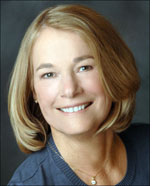|
By Laurel Corona
 SAN DIEGO—A white hair, an insect wing, missing clasps, a drop of salt, a wine stain. Such mundane things seem unlikely to glue readers’ eyes to the pages of a novel, but in the hands of an outstanding writer like Geraldine Brooks, they are turned into central characters in a wonderful fictionalized history of the Sarajevo Haggadah. SAN DIEGO—A white hair, an insect wing, missing clasps, a drop of salt, a wine stain. Such mundane things seem unlikely to glue readers’ eyes to the pages of a novel, but in the hands of an outstanding writer like Geraldine Brooks, they are turned into central characters in a wonderful fictionalized history of the Sarajevo Haggadah.
The Sarajevo Haggadah was created in Spain in the fourteenth century, making it one of the oldest Sephardic Haggadot in the world. Beautifully and brilliantly crafted, it is illuminated with colorful miniature illustrations of key scenes in the Bible, from the creation through the death of Moses—a bit of a mystery in that Jews at that time considered such illustrations to be forbidden graven images.
Working backward in time, Brooks creates a story explaining how the Haggadah came into existence, as well as its subsequent history. Her protagonist, Hanna Heath, an Australian rare books expert, has been brought to Sarajevo to establish the Haggadah’s authenticity and participate in its conservation. Proceeding with the meticulous eye of the archaeologist, Hanna sees tiny details of what is both present and missing in the tattered book, and from these things more than six centuries of history are revealed.
Brooks interweaves two different approaches to the story. One, reminiscent of Annie Proulx’ accordian in The Accordian Diaries and Susan Vreeland’s lost Vermeer painting in Girl in Hyacinth Blue, traces the Sarajevo Haggadah through a series of free-standing short stories. Hanna makes a discovery of a tiny speck of material (Brooks got the idea for this approach from watching the actual conservator’s excitement at discovering what looked like a crumb of centuries-old bread) and from that, the readers is taken into an imagined tale that reveals what scientist Hanna can only guess at. She discovers that one stain on a page in the Haggadah was made with salt water.
Though Jews might be tempted to say that it’s easy to guess how salt water might get on the pages of a book used in the Pesach Seder, they would be very wrong about this particular stain, and particularly wrong to think it had happened in any ordinary way. All Hanna knows it that the salt was from the sea. Brooks fills in the rich possibilities.
The second strand of Brooks’ narrative tells Hanna’s own story. Through her work on the Haggadah, she comes to understand how attitudes toward human differences have contributed to the survival or destruction not just of objects of art but individual lives, and whole cities and countries as well.
The librarian Ozren, her lover, tries to explain to Hanna how many Sarajevans felt about the terrible civil war in their city. "Years ago," he explains to Hanna, "we watched Lebanon fall
Go to the top of right column
| |
apart and said, 'That's the Middle East, they're primitive over there.' Then we saw Dubrovnik in flames, and we said, ‘We're
different in Sarajevo.' That's what we all thought. How could you possibly have an ethnic war here, when every second person is the product of a mixed marriage?” On a personal level, human divisiveness is illustrated in Hanna’s relationship with her cold and overbearing mother, as well as in her own lack of ability to understand the realities of life for a lover whose agony over the fate of his family in Sarajevo is both intimate and illustrative of the price paid by whole societies when ethnic intolerance is allowed to run wild.
The value of embracing diversity is also a strong theme in the book, beginning with Brook’s factually-based account of the Muslim man who risked his life in the 1940s conflict to go into the museum where the Haggadah was archived, remained calm enough under heavy shelling to crack the safe where it was kept, and then rushed through the violent streets of Sarajevo to carry it safely out Of the hands of the Nazis, who had targeted it for destruction. This serves as a one of two literal bookends, as Brooks’ backward trip in time takes the reader in the closing story to Seville in the last years of the period of religious tolerance known as the Convivencia. There, she imagines a story that explains how the combined efforts of a Jewish calligrapher and a Muslim artist might have resulted in the creation of this precious manuscript.
However, what really distinguishes this book from many other works of historical fiction is Brooks’ atonishing level of research. Want to know how paints were made in the Middle Ages, or how animal skins were turned into the vellum pages of illuminated manuscripts, or how paintbrushes were devised to make almost microscopic lines in miniature paintings? It’s all here, in fascinating detail, and even if you think you won’t be interested in such technicalities, my guess is that you will be.
Throughout, with the deftness of a painter working on details with a one-hair brush, Brooks adds a subtle moral commentary. As the haggadah passes through one custodian’s hands after another, a wide range of both selfish and altruistic reactions to possessing it are exposed. At times non-Jews show more respect for the haggadah than Jews do, and the moral high ground of the story comes from some very surprising characters.
A Pulitzer Prize winner for her novel March (which presents the story of Little Women from the point of view of the absent father, a Union soldier in the Civil War), Geraldine Brooks shows once again her tremendous ability to sweep readers up into what is both a rich learning experience and an intense, rewarding story.
|

